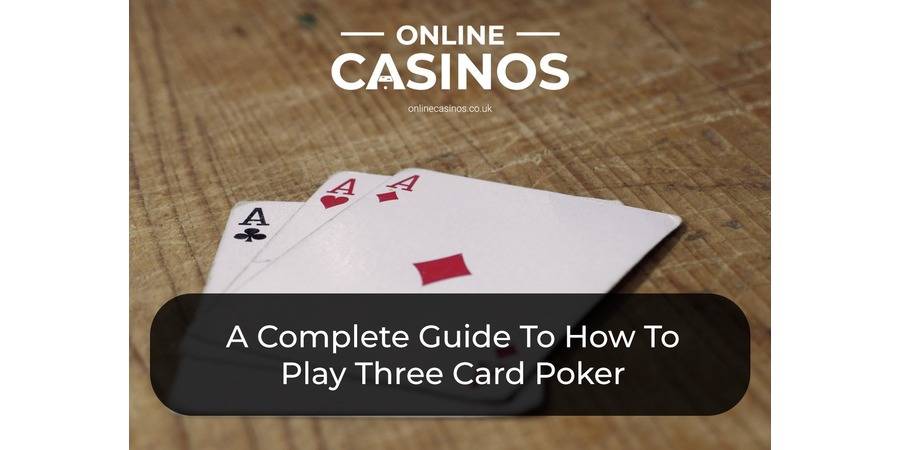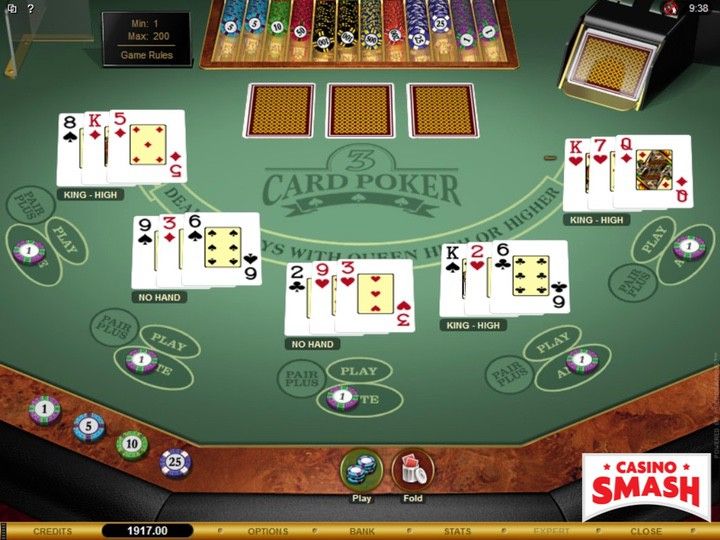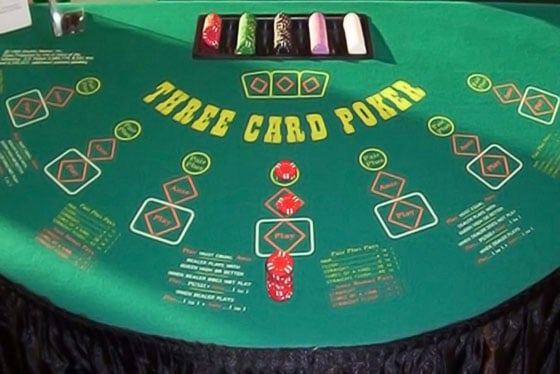
3 Card Poker uses the name 'poker' because it uses the standard poker hand ranking order but it's more of a casino game than a poker game per se. You can alter your bets slightly to chase different premium or bonus hands but there's no poker strategy - eg deciding which cards to keep or draw, making bets against other players - involved. Three card poker rules work the same online and in live dealer games. Playing three card poker with the 6-card bonus or the pair plus is an exciting way to win more money. The only way to play the additional bet is to learn and know the 3 card Poker rules work and the possible outcomes. Three Card Poker is played with a single deck of cards, shuffled for every hand. That’s true regardless of whether you’re playing in a live casino or online casino. In live casinos, the shuffling usually is done with an automatic shuffling machine. Standard blackjack-sized, seven-player tables are used in live casinos. Although Three Card Poker is a very simple game to play, there are some important rules that must be followed in order to qualify for bonuses or make further bets. One of the most basic rules is that every player must have a bet on the table to play.
Usually, when someone mentions poker, we think about one of the game variations played against other players. Whether it’s Hold’em, Omaha, or some other variant, and whether you play it in a poker room or at home, your goal is to win chips off of other players at the table.
However, casinos have come up with several games that have its roots in popular poker variants, but are played against the house instead. Like all other table games, these have an inherent house edge so your skills can only help you so much. 3-Card Poker is one of the most popular options in this group.
3-Card Poker is a very simple and straightforward game that doesn’t force you to make any complicated decisions. It’s a great choice if you’re just looking to blow off some steam or have a bit of fun in the casino pit as the house edge is around 2%, provided you stick to the rather simple basic strategy for the game.
3-Card Poker Rules
While there can be several players playing at the table at any given time, your only goal in 3-Card poker is to beat the dealer. Whether you win or lose in a hand has nothing to do with what other players are dealt or what decisions they make.
To start with, you’ll place the Ante wager and, optionally, the Pair Plus wager.
Once all bets are in, the dealer will give all players three cards, face down, and they’ll take three cards for themselves, also face down, so you won’t know what you’re up against.
Once you’ve had a chance to check your hand, you’ll decide whether you want to keep on playing or fold. If you fold, you’ll give up on the chance to win the hand and the dealer will collect your ante bet.
If you want to play on, you’ll need to place the Play bet, which is equal to the size of the Ante bet. After all players have made their decisions, the dealer will turn over their hand and there will be a showdown.
Payouts in 3-Card Poker

When you get to a showdown, your hope is to have beaten the dealer’s qualifying hand. If they have a hand that’s Queen-high or better and you beat them, you’ll get paid even money on both your Ante bet and your Play bet.
If their hand is Jack-high or worse, the dealer doesn’t qualify, and you’ll only get paid even money on the Ante bet, while the Play bet is pushed back to you (i.e., no profit or loss).
There are also bonus payouts if you win the Ante bet with a straight or better.
The Pair Plus bet is optional and it’s not tied to the outcome of the hand. You’re basically betting that you’ll get dealt a pair or better. If that happens, regardless of whether you win or lose the actual hand, you’ll get paid on the Pair Plus bet according to the separate payout table, which usually looks something like this:
- One pair: 1 to 1
- Flush: 4 to 1
- Straight: 5 to 1
- Trips: 30 to 1
- Straight flush: 40 to 1
Playing 6-Card Bonus
Another type of side bet usually available in 3-Card Poker is the 6-Card Bonus wager. For this one, you’ll need to combine all six cards, your own and the dealer’s, to make a hand.
Payouts for 6-Card bonus start from three of a kind and go up to a 6-card straight flush (9 through Ace of the same suit), which usually pays 1,000 to 1.
In some casinos, there is also a progressive jackpot that can be won if you get lucky and make the 6-card straight flush in diamonds, often paying six-figure amounts.
This 10% Progressive on 3 Card Poker was struck by a Straight Flush for $9,684 jackpot. #commercecasinopic.twitter.com/yuteu3FEeA

— Commerce Casino (@CommerceCasino) June 22, 2019
Basic 3-Card Poker Strategy
You don’t get to make many decisions in any individual hand of 3-Card Poker. The only thing which you have control over is whether you’ll continue in a hand or not once you receive the three cards.
As the general rule of thumb, if your hand is Q64xx or better you should continue. Otherwise, you should fold and give up your Ante bet. By sticking to this strategy, you’ll ensure the house doesn’t have the bigger edge than 2%.
Of course, like with almost all table games, side bets have worse odds than the actual game, so they’re a bad idea from the purely mathematical perspective. On the other hand, they definitely make 3-Card Poker a much more exciting and dynamic game with the potential for big scores, so it boils down to what you’re looking for when you sit down to play.
Either way, 3-Card Poker is a fairly reasonable table game that’s not hard to learn and you can play a decent number of hands without digging too deep into your wallet. Plus, if you go on a bit of a lucky run and get dealt a few strong hands, you can still win big without risking crazy amounts of cash.
Other Posts You'll Enjoy
- Three Alternative Card Games to Poker
Another great article for the Cardplayer Lifestyle poker blog from a guest contributor.
- The Benefits of Playing Table Game Versions of Poker
While poker-themed table games at casinos tend to be scoffed at by poker purists, they can still provide a welcome respite when you're just looking…
- Poker Rooms Should Start Spreading Wild Card Games
We at Cardplayer Lifestyle think it's high time some innovations be made in live poker rooms, namely the introduction of wild card poker games. Check…
- Auction News: Playing Cards, Cheating, Poker Literature, and More
Many fans of poker are also fans of collecting. If that statement describes you, you'll probably love to know all about the upcoming auction of…
- Give Wild Card Poker Games a Chance
Tired of Texas Hold'em? Only Omaha for you? Simply sick of Stud? Cardplayer Lifestyle recommends you add some spice to your poker sessions by trying…
- A Comprehensive Guide to Chinese Poker
You may or may not have heard of Chinese Poker and Open Face Chinese Poker, but either way, the rules and what the games are…
You’re probably heard of one of the oldest card games played at casinos—poker. But have you ever heard of Three-Card Poker? This is one of my favorite card games played at tables or even on machines at select casinos.
Being just one single card more than a hand of blackjack, this game is far simpler than other popular poker variants. It’s a great way to learn the ins and outs of the game before you hit the Texas Hold ’Em tables (or even just a friendly game with a group of buddies).
The rules are similar, with a few exceptions. In the following article, I’ll be going over the rules and payouts that are common for this game.
A Brief History
The casino variant of this game was first created pretty late in the game, so to speak. I was surprised to learn three-card poker was created in 1994 and wasn’t patented until 1997. Created by Derek Webb, the goal was to create a version of poker that was played speedily, like other table games.
Webb had three ideas in mind as he created this variant. He wanted the rules to be easily understood, the payouts were meant to be large enough to attract players, and the house edge was such that casino owners would be keen on adopting it into their businesses.
Webb established a business he called Prime Table Games in order to market his game to casinos in the United States and United Kingdom. Because the UK had regulations against such a table game, his application wasn’t strong enough to convince regulators to change their rules. It was suggested that he gain some experience in the US first.
Grosvenor Casino 3 Card Poker Rules
He caught his first break in Mississippi at the Grand Casino Gulfport when casino VP Barry Morris adopted the game after Webb was rejected in Las Vegas, Reno, and Atlantic City. Just three years later, UK gaming regulations were adjusted to allow the introduction of Three-Card Poker in 2002.
The Basics and Advantages
This game is very similar to a standard game of poker, like Five-Card Draw or even Texas Hold’em. The main difference? You guessed it—you get three cards to make up your best hand instead of the standard five-card hand you’d get with the other two variants we mentioned.
Another difference here is that, as far as which hand you need to beat, it simply comes down to your hand versus the dealer’s hand. That’s right, there’s no need to worry about the other players at the table; though they may or may not be there playing, they also aren’t worried about beating you. This being the case, there’s no need to focus on bluffing or worrying about whether the guy sitting next to you has a superior hand.
Initial Betting
Payouts are obviously going to be vastly different in this game since there’s not a pot in the middle of the table. In order to play, you have to place an ante bet at least.
In addition to the ante bet, you have the option to place an additional bet. The optional bet is the pairs plus bet. After you receive your cards, you also have the option to place a play bet, which is essentially a raise bet.
The optional play bet is whether you want to play your hand against the dealer. Both the ante and play bet only pay out if your hand beats the dealer’s, but the pairs plus bet is paid based on whether you get a pair of cards or better dealt to you. The play bet must be equal to the ante bet. If you don’t place the play bet, you are essentially folding your hand, and lose your ante bet.
After the Cards Are Dealt
Casino 3 Card Poker Rules For Beginners
Now that you have your cards and all possibilities of bets have been laid down, here are the different hands you may get and the probability of each.
In a deck of 52, there are a total of 48 straight flush possibilities. Because there are a total of 22,100 possible hands, that equals to .22%, or roughly 1 out of 460.
Next, we have three of a kind. There are a possible 52 three of a kind possibilities in a standard deck. This gives us .24%, or 1 out of 425.
Now, we’re nearing the more likely, but not entirely likely, scenarios. With a straight, we have a possible 720 three card straights in a deck. With these numbers, we’re looking at 3.26%, or roughly 1 out of 31.
As we move closer to the most likely hands, we are now looking at the same suited flush. Here, we have a possible 1,096 flush options in our deck. This gives us a 4.96%, or roughly 1 out of 20.
Moving along, we are now at the pair. There are a total 3,744 possible pairs in a deck of 52. This stands at 16.94%, or roughly 1 in 6.
At this point, we’re at the most likely hand you are to receive of them all. This is known as the high card hand, and it’s the hand you’ll receive if none of the other listed hands are dealt. There are a whopping 16,440 total possible hands that aren’t listed above in a standard deck. This is the equivalent of 74.39%, or roughly 3 in 4.
Basic Payouts
After the ante and pairs plus bets are placed, the cards are dealt. If the dealer doesn’t receive a queen or better, their hand is folded, the ante bet is returned, and the optional play bet is no longer on the table. If the dealer’s hand is in play, the optional play bet must be equal to the ante bet.
After hands are compared, the ante and play bets are paid out 1 to 1, and an ante bet bonus is paid out as follows: a straight is paid out 1 to 1, or double your bet, three of a kind is paid out 4 to 1, or five times your bet, and a straight flush is paid out 5 to 1, or six times your bet. Most of the time, the house pays the player for ties.
The most common payouts for this bonus pay table are: 50 to 1 for a mini royal in spades, 10 to 1 for a mini royal, 4 to 1 for a straight flush, and 3 to 1 for three of a kind.
If you decide not to place the play bet, your ante bet is forfeited, but the pairs plus bet is still in play.
Pairs Plus
Now that you’re familiar with the different strategy of hands you’re going to receive in this game, let’s talk about the pairs plus bet. This is my favorite bet to lay down because the payouts can get astronomical, and neglecting to put down this bet can have you kicking yourself in the rear when the right cards are dealt.
First, we’ll look at the payouts for a pairs plus pay table without mini royal.
As the name of the bet suggests, you’ll only receive a payout if you receive better than a pair. A pair pays out 1 to 1, meaning you get your bet times two if you score a pair.
Next up, we have the flush. A flush is when all of the cards in your hand are of the same suit. With this hand, the payout is 3 to 1, meaning you will get four times your pairs plus bet.
A straight is when you get three consecutive cards of any suit, including ace, two, and three, all the way up to queen, king, and ace. This will pay out 6 to 1, or seven times your bet.
Three of a kind is pretty self explanatory. The payout here is 30 to 1, or 31 times your bet.
Finally, a straight flush is the ultimate combination of a straight and a flush, or three consecutive cards of the same suit. This hand will pay out a whopping 40 to 1, or 41 times your bet.
Now, let’s move on to the pay table when the house offers payouts for mini royals. A pair pays out 1 to 1 here as well. A flush is paid 3 to 1, straights are paid out 6 to 1, three of a kind are 25 to 1, straight flush gets 40 to 1, and a mini royal is paid out 80 to 1.
Conclusion
The primary reason this game was so enticing to this gambler is because of the pairs plus bet. The first time I played the game, I won $460 on a hand by betting $10 on each of the three bets because I got the much desired straight flush. As you can see, the pairs plus can really add up even if you don’t beat the dealer’s hand.
Playing this game will give you a feel of poker while allowing you to play without the stresses of playing against a table of competitors, making it feel a little like blackjack in the style of play. Good luck and don’t forget to place those pairs plus bets!